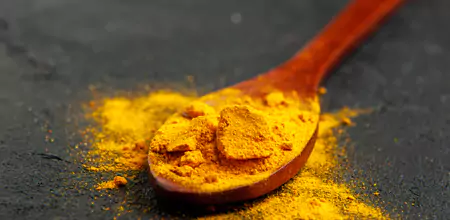Introduction
Turmeric (Curcuma longa) is a bright yellow-orange spice that has been used for centuries in traditional cooking and crafts across South Asia. Often called the “golden spice,” turmeric’s vivid color and warm, slightly bitter flavor make it a versatile ingredient in curries, rice dishes, beverages, and baked goods. The spice is obtained from the dried, powdered root of the turmeric plant and contains key compounds, such as curcumin, which contribute to its color and characteristic flavor.
A Brief History
Turmeric’s history stretches back thousands of years. It has been used as a culinary spice, a textile dye, and a ceremonial or medicinal ingredient in many cultures. In South Asia, turmeric features prominently in cuisine, festivals, and traditional remedies. Its vivid pigment also made it a natural choice for coloring fabrics and foods long before modern dyes were available.
Nutritional Profile (approx. per 1 tablespoon / 7g)
- Calories: ~29 kcal
- Carbohydrates: ~6 g
- Protein: ~1 g
- Dietary fiber: ~2 g
- Micronutrients: manganese, iron, small amounts of vitamin C
- Curcuminoids: natural pigments including curcumin (amount varies by source)
Health & Well-Being: What Turmeric Supports
Turmeric is widely used as part of wholesome diets and cultural wellness traditions. Below are commonly described areas where turmeric is incorporated into daily life:
- Digestive support: Turmeric is often used in cooking to complement digestion and add a gentle warmth to meals.
- Antioxidant support: Compounds in turmeric contribute antioxidant properties that help protect cells from everyday oxidative stress.
- General wellness: Turmeric is commonly included in nourishing drinks and meals for variety, color, and balanced flavor.
How to Use Turmeric in Cooking
Turmeric can be used fresh or ground. Fresh turmeric root resembles ginger but has bright orange flesh. Ground turmeric is convenient and shelf-stable. A few practical ways to introduce turmeric into your meals:
- Golden Milk: Warm milk or plant milk with turmeric, a pinch of black pepper, and a touch of sweetener.
- Rice & Grains: Add a small pinch to rice, quinoa, or pilaf for color and mild flavor.
- Soups & Stews: Stir in turmeric early in cooking so the flavor blends well with aromatics.
- Smoothies: Blend ¼–½ teaspoon of ground turmeric with fruits like mango or banana for a tropical note.
- Roasted Vegetables: Toss root vegetables or cauliflower in oil, turmeric, salt, and roast until caramelized.
Tips to Maximize Flavor & Use
- Pair with black pepper: A small amount of black pepper can help release flavor compounds and improve absorption of certain turmeric components.
- Use a little oil: Turmeric’s key compounds are fat-soluble, so cooking with a healthy oil (olive, coconut) helps bloom the flavor.
- Toast for aroma: Briefly toasting whole or ground turmeric in a dry pan intensifies its aroma before adding liquid.
Choosing & Storing Turmeric
For fresh turmeric, choose firm, unwrinkled roots. For ground turmeric, pick bright, deeply colored powder with a fresh, earthy scent. Store ground turmeric in an airtight container away from heat and light; it will keep its potency longer when protected from air and sunlight.
Traditional & Cultural Uses
Turmeric has cultural significance in many regions — used in festivals, rituals, and traditional recipes. It’s also employed in natural dyeing and as a gentle colorant for foods and crafts.
Precautions & Practical Advice
Turmeric used in normal culinary amounts is safe for most people. If you consider concentrated supplements or high-dose extracts, discuss them with a healthcare professional — especially if you take medication or have a medical condition. Avoid excessive intake that causes stomach discomfort.
Conclusion
Turmeric is a versatile, flavorful ingredient that adds color, depth, and a gentle warmth to countless dishes. Whether you add a pinch to your rice, sip a warm cup of golden milk, or experiment with turmeric in smoothies and baked goods, it’s an easy and tasty way to diversify your diet. Embrace turmeric as a kitchen staple and enjoy the culinary variety it brings to everyday meals.
